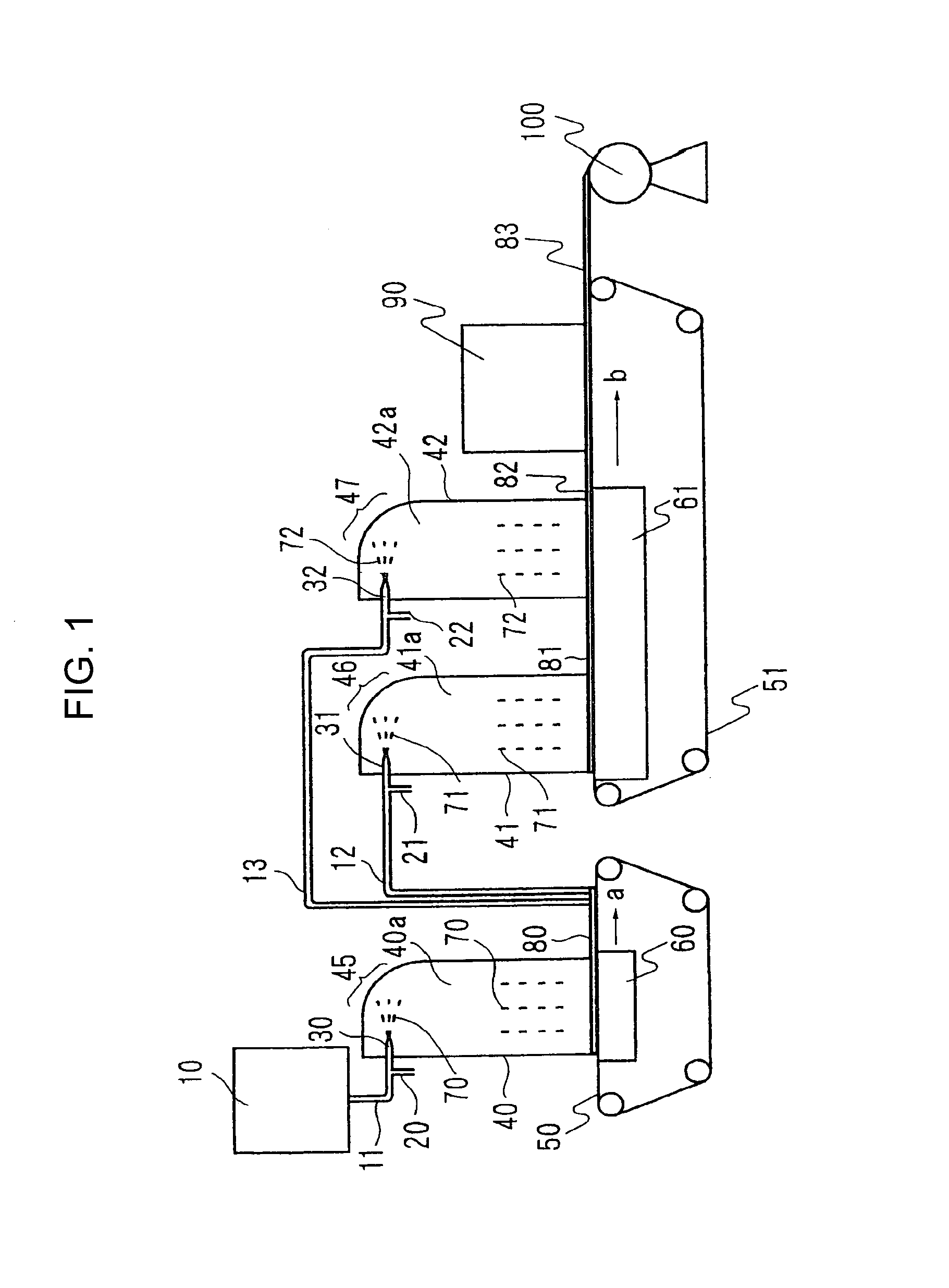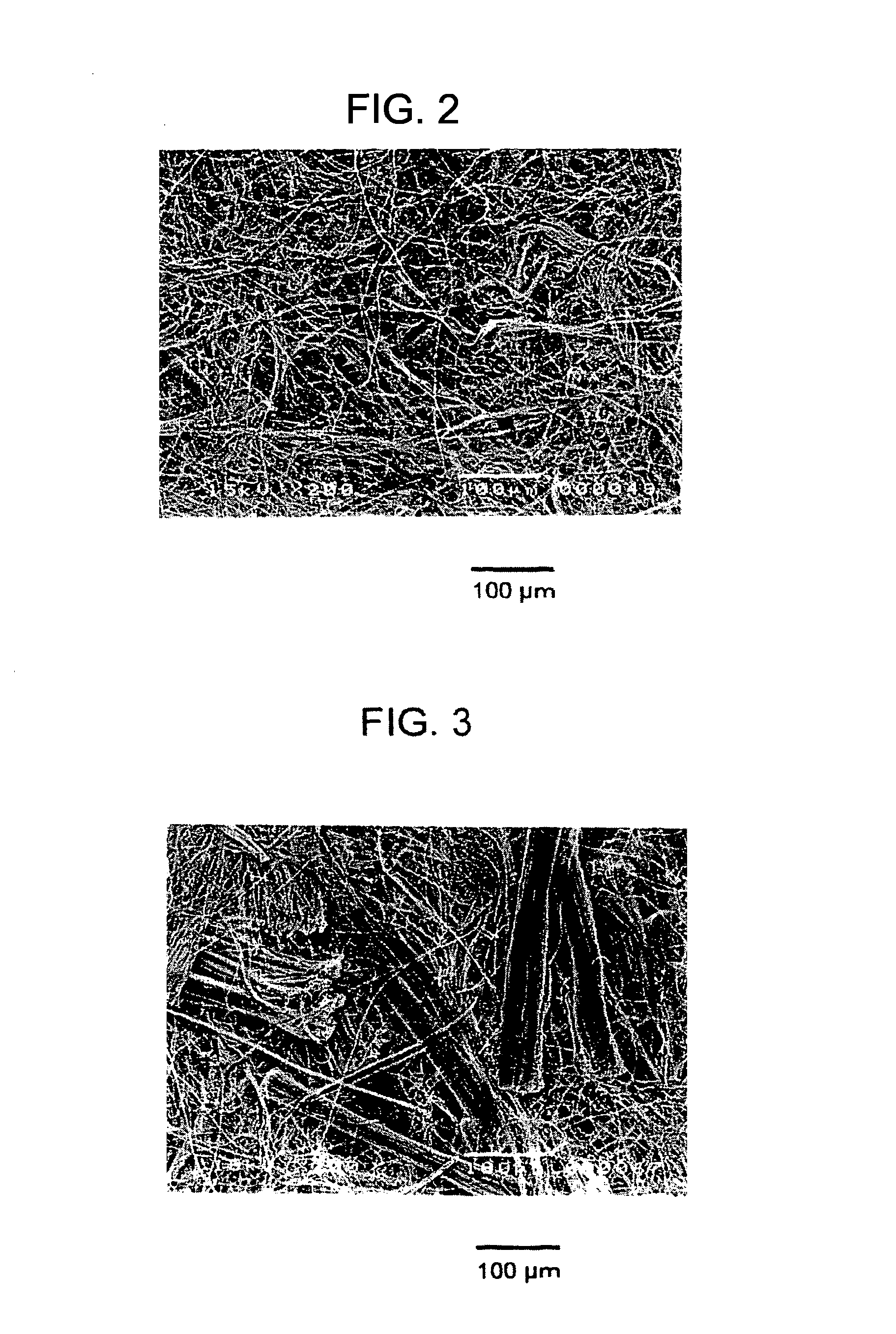Fine-fibers-dispersed nonwoven fabric, process and apparatus for manufacturing same, and sheet material containing same
a technology of fine fibers and nonwoven fabrics, applied in the field of fine fibers-dispersed nonwoven fabric, a process and an apparatus for manufacturing the same, and a sheet material comprising the same, can solve the problems of high pressure loss, insufficient filtering characteristics or pliability, etc., and achieve excellent properties, small pressure loss, and small pressure loss.
- Summary
- Abstract
- Description
- Claims
- Application Information
AI Technical Summary
Benefits of technology
Problems solved by technology
Method used
Image
Examples
example 1
[0090]Islands-in-sea type fibers (fineness=1.7 dtex) having 25 island components of high-density polyethylene and polypropylene in a sea component of polylactic acid were prepared by a composite spinning method, and cut to a fiber length of 1 mm. The resulting islands-in-sea type fibers were dipped in a 10 mass % aqueous solution of sodium hydroxide, and the sea component of polylactic acid was extracted and removed by hydrolysis. Then, the product was air-dried to obtain bundled aggregates of the fine fibers A (a fiber diameter=2 μm; a fiber length=1 mm; adhesion rate of adhered substances=less than 0.02 mass %; sectional shape=circle, and islands-in-sea type) wherein high-density polyethylene and polypropylene were coexistent in each of the fine fibers. The resulting fine fibers A were drawn but not fibrillated. Each of fine fibers had substantially the same diameter in an axial direction thereof.
[0091]On the other hand, islands-in-sea type fibers (fineness=2 dtex) having 61 islan...
example 2
[0100]The bundled aggregates of the fine fibers A prepared as in Example 1 and aggregates of polyester fine fibers (Teijin Ltd.; fineness=0.11 dtex; fiber diameter=3.2 μm; a fiber length=3 mm; adhesion rate of adhered substances=less than 0.02 mass %) which was washed with acetone to remove adhered substances (mainly a fiber auxiliary) were charged into the mixer at a mass ratio of 60:40, and loosened and mixed. The polyester fine fibers were drawn and not fibrillated. Each of polyester fine fibers had substantially same diameter in an axial direction thereof.
[0101]The mixture of the aggregates of the fine fibers was supplied to a cylindrical ejector having a cross-sectional circular shape at an ejecting opening (diameter=7 mm), and at the same time, a compressed air (pressure 6 kg / cm2) was introduced from the compressed-gas inlet at an inside position near to the cylindrical ejector. The mixture of the aggregates of the fine fibers was ejected from the cylindrical ejector (wherein ...
example 3
[0105]Islands-in-sea type fibers (fineness=8.8 dtex) having about 3900 island components of poly-4-methylpentene in a sea component of polyester copolymer were prepared by a melt blend spinning method, and cut to a fiber length of 0.5 mm. The resulting islands-in-sea type fibers were dipped in a 10 mass % aqueous solution of sodium hydroxide, and the sea component of polyester copolymer was extracted and removed by hydrolysis. Then, the product was air-dried to obtain bundled aggregates of the fine fibers C (a fiber diameter=0.4 μm; a fiber length=0.5 mm; adhesion rate of adhered substances=less than 0.02 mass %) of poly-4-methylpentene. The resulting fine fibers C were drawn but not fibrillated.
[0106]Further, the bundled aggregates of the fine fibers A were prepared as in Example 1.
[0107]Thereafter, the bundled aggregates of the fine fibers A and the bundled aggregates of the fine fibers C were charged into the mixer at a mass ratio of 50:50, and loosened and mixed. The mixture of ...
PUM
| Property | Measurement | Unit |
|---|---|---|
| length | aaaaa | aaaaa |
| diameter | aaaaa | aaaaa |
| diameter | aaaaa | aaaaa |
Abstract
Description
Claims
Application Information
 Login to View More
Login to View More - R&D
- Intellectual Property
- Life Sciences
- Materials
- Tech Scout
- Unparalleled Data Quality
- Higher Quality Content
- 60% Fewer Hallucinations
Browse by: Latest US Patents, China's latest patents, Technical Efficacy Thesaurus, Application Domain, Technology Topic, Popular Technical Reports.
© 2025 PatSnap. All rights reserved.Legal|Privacy policy|Modern Slavery Act Transparency Statement|Sitemap|About US| Contact US: help@patsnap.com



